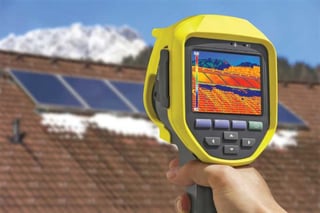
Most roofs are not watertight all the time. Roofing systems, both low-sloped (flat) and pitched, will most likely eventually spring a leak, even with the proper recommended maintenance and inspections. But what about newly installed low-sloped roofs, can one expect those to be watertight? Typically, on a newly constructed building, any minor leaks that turn up during construction can be dealt with immediately by the installer. Also, newly installed roofs on new and old buildings will undergo inspections and sometimes specified testing of seams and components for issuance of the manufacturer’s and installer’s warranty of water tightness for a specified period of time. However, ensuring that your newly installed roof is absolutely watertight becomes more critical if it is being covered by rock ballast or a landscaped greenspace or if the roof protects valuable artwork or irreplaceable property. Determining the location, origin, and extent of wet substrates is also critical for existing buildings when trying to determine if repair or complete replacement is more appropriate.
In the article, Everything Leaks: Testing to ensure watertightness at the outset, Ronald J. Ray, RA, CCS, CCA, CSI, AIA examines some the methods of roof testing, emphasizing their effectiveness and limitations.
Mr. Ray rightly points out that one of the time-honored methods for leak testing, flooding a roof, either non-scientifically or according to ASTM D5957, Standard Guide for Flood Testing Horizontal Waterproof Installations, is generally inappropriate. The National Roofing Contractors Association (NRCA) does not recommend flood-testing of new roof systems for identifying potential leak sources since “roof systems are designed to resist the passage of water with a minimal amount of hydrostatic pressure (i.e. flowing water), while waterproofing systems are designed to prevent the passage of water under hydrostatic pressure (i.e. standing water).” In addition, flooding does not test many of the key components such as flashings, terminations, and caps. There can also be structural considerations with the weight of the depth of water created on a large expanses of low-sloping roof. However, flood testing small areas is often a good diagnostic tool for forcing potential membrane issues to appear and to observe leak pathways.
With today’s technologies there are more reliable, practical, and precise electronic leak testing methods available for diagnosing and locating potential or actual roof leaks, with each being more appropriate under certain circumstances. The article examines:
- Infrared thermography: Non-destructive infrared thermography (or infrared imaging) works by detecting differences in temperature, since in the right conditions, water retains heat longer than insulations. This is generally less effective on newer roof systems or after insulation has been applied over the roofing membrane.
- Electrical capacitance/impedance testing: In this nondestructive procedure, a moisture meter is used to identify entrapped water within a roofing system. This method works due to the ability of water to store or conduct electrical energy. This can be a valuable diagnostic tool, but cannot quantify the percentage of moisture present or pinpoint the source, and it is less effective on new roofs.
- Nuclear hydrogen detection: Also known as the ‘backscatter’ methodology, nuclear hydrogen detection employs a radioactive isotope to emit high-speed neutrons aimed at the roof. To locate entrapped water, this method relies on detecting the “slowing” of fast neutrons by the hydrogen atom contained in water. This method’s limitations are similar to those for electrical capacitance/impedance testing.
- Low-voltage electrical conductance testing: Low-voltage electrical conductance testing specifically locates areas of open seams or tears (discontinuity) of the roofing membrane rather locating water. Generally the test is also effective on roofing membranes covered by ballast or vegetation and new roof membranes. In this process, the steel roof decking is electrically grounded, the roofing is dampened and a wire loop at the perimeter of the roof produces low-voltage electrical pulses. By detecting where a directional current is created to the grounded steel deck, discontinuities in the membrane can be located. This method is ineffective when a vapor retarder is present or with EPDM membranes (a very common roofing material) because they contain conductive carbon black.
- High-voltage spark testing: High-voltage spark testing is similar to low-voltage electrical conductance testing, but uses a 1000- to 30,000-volt direct current (DC). The moisture on the membrane and the wire loop are replaced with an electrically charged metal “broom” that will directly create a detectable current to the grounded steel deck at the location of gaps and tears (discontinuities). This method has similar limitations to the low-voltage conductance testing, but has the advantage of being applicable to vertically roofed surfaces also.
Other factors to be considered when choosing a system include the size of the roof, the relative costs of each test, the availability of skilled professionals, and that other less technological, yet still effective methods may be available.
CCA generally recommends taking an incremental approach, starting with interior and exterior observations with non-destructive moisture meters and infrared cameras in the hands of trained professionals with years of experience in diagnosing roofing issues. However, particularly with newer roofs, the technological methods discussed above are often clearly appropriate to identify potential areas of concern.
Continue reading this informative article by Mr. Ray to learn more.


